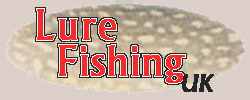 |
Lure fishing information especially for | |||||||||
| ||||||||||
Tackle, Tactics and ExperienceBaitcasting for Pike.In the spring of 1998 I took the plunge and converted to baitcasting gear, that is: a shorter rod, multiplier reel and braided line. Previously my set up for pike was as follows: a 10ft Daiwa Powermesh salmon spinning rod (15g to 60g casting range), a large Shimano fixed spool reel, and Berkeley Big Game mono in 12 lb and 15lb b.s. This served me well for 8 years or so and I could not envisage improving on this tackle.I had tried braided and fused non-stretch lines and been impressed with their sensitivity, but annoyed at their propensity to tangle when used on a fixed spool reel. A shorter rod had improved presentation because it was not so tiring to twitch and jerk plugs all day, twitches and jerks are often vital in stimulating pike to hit a lure. Non- or low-stretch line allows the twitch at the rod tip to directly affect the lure, especially when coupled with a stiffer rod. More violent rod manouevres did tend to cause tangles at the reel. I knew that I needed to use a multiplier to get the best out of braided lines but like most anglers reared on fixed spool reels I was reluctant to risk the horrors of birds-nests so often described by previous converts. However, I took the plunge and, despite inevitable teething troubles, I am now completely happy with the multiplier. My tackle now is as follows: either a Prowler Plus or Sledgehammer 1 rod from Dave Lumb Specialist Tackle, ABU Ambassadeur 5501-C3 or 6501-C3 multiplier (left hand wind) and various brands of 50lb to 100lb b.s. braided line. The reels are fine, but then, ABU have been making multipliers for long enough to have got it about right by now! It is a shock realising you have no backwind facility and any line has to be given with the clutch, but the clutch is so sweet I have not had a problem with this. In fact it is exciting, feeling the line being pulled off when the rod is hooped over and a good pike has decided to go back to the bottom of the river for a while! I am happy with all the different braided lines I have tried but I recommend any that can be tied with a simple palomar knot, it is so much easier to replace a leader with cold and wet hands if the knot is easy to tie. The reasons for such a seemingly high breaking strain are several. Firstly lures are expensive and snags are plentiful, so strong line saves money. Braided line is quite thin and there is no casting or presentational advantage to be gained from finer line. Occasional overruns when casting can stop a plug very abruptly in mid-flight, the braid will not stretch and if it is not strong enough it will break, letting an expensive plug fly off across the river. Braid seems to last for ages so the initial expense is not so bad viewed over a couple of years or more. With such strong and unforgiving line the wire trace becomes subject to high stresses, and will deteriorate rapidly with repeated casts. I used to use various wires in the 15lb to 30lb b.s. range, these are totally inadequate when using braided line and heavy lures. I am currently using 90lb b.s. seven strand, I know this sounds heavy but I cannot say it affects presentation except when using surface baits, lighter lures and neutral buoyancy lures, in those circumstances I will use lighter traces. I have found that the heavier-duty traces last for ages and the lure clip will usually be worn out before the wire is damaged. Choosing lures for baitcasting.The tackle described above will land any pike quickly, but the lure must be tough enough to take the strain. Remember that pike grow big and have sharp teeth! Will the lure stay in one piece when that monster tail-walks, or you have to drag a big one through a weedbed? Strength counts, check split rings, hook-hangers and trace attachment eyes. Don't use poorly-constructed lures, they will fail when you need them most. | ||||||||||